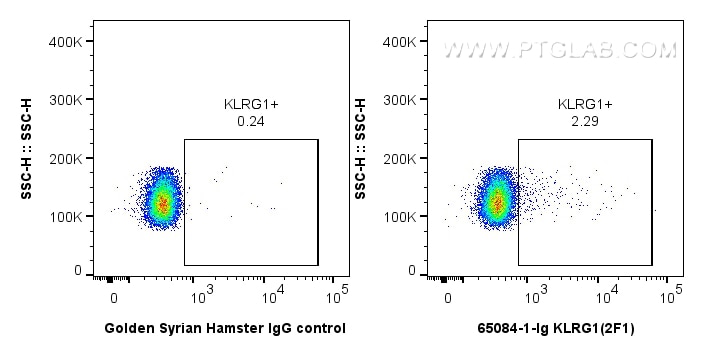Anticorps Monoclonal anti-KLRG1
KLRG1 Monoclonal Antibody for FC
Hôte / Isotype
Golden Syrian Hamster / IgG
Réactivité testée
souris
Applications
FC
Conjugaison
Non conjugué
CloneNo.
2F1
N° de cat : 65084-1-Ig
Synonymes
Galerie de données de validation
Applications testées
| Résultats positifs en cytométrie | splénocytes de souris, |
Dilution recommandée
| Application | Dilution |
|---|---|
| This reagent has been tested for flow cytometric analysis. It is recommended that this reagent should be titrated in each testing system to obtain optimal results. | |
| Sample-dependent, check data in validation data gallery | |
Informations sur le produit
65084-1-Ig cible KLRG1 dans les applications de FC et montre une réactivité avec des échantillons souris
| Réactivité | souris |
| Hôte / Isotype | Golden Syrian Hamster / IgG |
| Clonalité | Monoclonal |
| Type | Anticorps |
| Immunogène | s/o |
| Nom complet | killer cell lectin-like receptor subfamily G, member 1 |
| Numéro d’acquisition GenBank | BC101953 |
| Symbole du gène | Klrg1 |
| Identification du gène (NCBI) | 50928 |
| Conjugaison | Non conjugué |
| Forme | Liquide |
| Méthode de purification | Purification par affinité |
| Tampon de stockage | PBS with 0.09% sodium azide |
| Conditions de stockage | Store at 2-8°C. Stable for one year after shipment. |
Informations générales
KLRG1 (killer cell lectin-like receptor subfamily G, member 1) is a C-type lectin inhibitory receptor that contains an immunoreceptor tyrosine-based inhibitory motif (ITIM) in its cytoplasmic domain. KLRG1 is expressed by subsets of NK and T cells, existing both as a monomer and as a disulfide-linked homodimer (PMID: 10741410; 19604491). It is considered to be a cell differentiation marker for NK and T cells and is strongly induced by viral and other infections (PMID: 20373518). Through interactions with members of the cadherin family, KLRG1 plays an inhibitory role on NK- and T-cell function (PMID: 19009530; 20373518).
Protocole
| Product Specific Protocols | |
|---|---|
| FC protocol for KLRG1 antibody 65084-1-Ig | Download protocol |
| Standard Protocols | |
|---|---|
| Click here to view our Standard Protocols |


